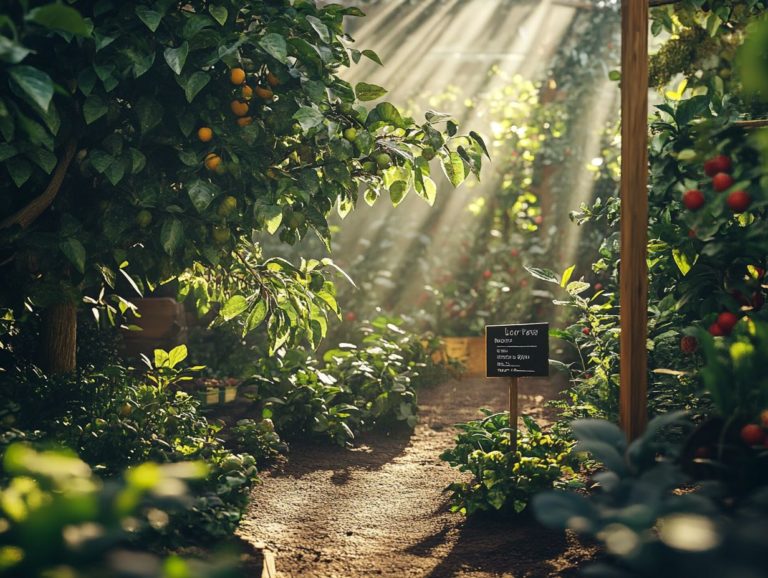“10 Best Plants for Soil Restoration”
Soil health is imperative in agriculture, influencing everything from crop yield to environmental sustainability. Get ready to transform your land into a thriving ecosystem!
This article delves into ten remarkable plants that can substantially aid in soil restoration. From Comfrey to Lupines, each plant offers unique benefits, such as improving soil structure, enhancing nutrient availability, and fostering biodiversity.
You ll also discover best practices for integrating these plants into your farming routine, common pitfalls to sidestep, and the long-term advantages of investing in soil health.
Contents
- Key Takeaways:
- 1. Comfrey
- 2. Alfalfa
- 3. Clover
- 4. Buckwheat
- 5. Fava Beans
- 6. Sunn Hemp
- 7. Red Clover
- 8. Cowpeas
- 9. Winter Peas
- 10. Lupines
- Unlock the Secrets of Soil Restoration: Why It Matters!
- How Do These Plants Help with Soil Restoration?
- What Are the Best Practices for Using These Plants for Soil Restoration?
- How Can These Plants Be Incorporated into Crop Rotation?
- What Are the Common Mistakes to Avoid When Using These Plants for Soil Restoration?
- What Are the Long-Term Benefits of Using These Plants for Soil Restoration?
- Frequently Asked Questions
- 1. What are the top 10 best plants for soil restoration?
- 2. How do these plants help with soil restoration?
- 3. Can these plants be grown in any type of soil?
- 4. Are these plants easy to maintain?
- 5. Can these plants be used for both large scale and small scale soil restoration projects?
- 6. How long does it take for these plants to restore soil health?
Key Takeaways:

- Comfrey, alfalfa, and clover are top plants for soil restoration. They fix nitrogen and improve soil health.
- These plants work best in crop rotation. Avoid overgrazing to enhance their effectiveness.
- Incorporating these plants can lead to increased crop yields and reduced reliance on chemical fertilizers.
1. Comfrey
Comfrey enhances soil health and fertility. It s a valuable asset for sustainable gardening or permaculture projects.
With its deep taproots, comfrey brings essential nutrients to the surface. It also contributes to improved soil structure and moisture retention.
This plant fosters a thriving ecosystem by attracting beneficial insects and enhancing microbial life in your compost pile.
As a natural nutrient booster, comfrey provides nitrogen, phosphorus, and potassium when used as mulch or compost. Its leaves decompose rapidly, enriching your soil while promoting vigorous plant growth.
Beyond agricultural benefits, comfrey is celebrated for its medicinal qualities, including anti-inflammatory properties and wound healing benefits. It s a versatile addition to your herbal remedies.
Cultivating comfrey is straightforward; it flourishes in well-drained soil and partial sunlight, requiring minimal care once established. Enjoy its rewards for years to come.
2. Alfalfa
Alfalfa is an exceptional nitrogen-fixing plant. It significantly boosts soil fertility by enhancing nitrogen levels, benefiting various garden plants and crops.
This remarkable legume plays a crucial role in improving soil structure and moisture retention. Its extensive root system delves deep into the earth, aerating the soil and retaining moisture.
Turning the biomass produced by alfalfa back into the soil adds rich organic matter, amplifying nutrient availability.
Its lush, dense foliage attracts beneficial insects and organisms, promoting biodiversity and fostering a balanced ecosystem in your garden. Integrating alfalfa can transform an ordinary garden into a thriving habitat.
3. Clover
Clover excels at fixing nitrogen in the soil, boosting soil fertility, and nurturing the growth of various garden plants.
This multifunctional wonder acts as a natural fertilizer, enriching the soil with essential nutrients that other crops crave. Incorporating clover into your sustainable gardening practices contributes to a healthier ecosystem.
Its robust root systems prevent soil erosion, protecting the surface from harsh weather and enhancing water retention.
Clover attracts beneficial insects like bees and ladybugs, crucial allies in pollination and pest management. By fostering a balanced environment, using clover supports a flourishing garden ecosystem.
4. Buckwheat
Buckwheat is an exceptional soil-building plant. It enhances nutrient cycling and improves soil structure.
This makes it a prime choice for cover cropping in organic farming and sustainable gardening.
Its rapid growth and attractive flowers attract beneficial insects. This nurtures a thriving ecosystem in your garden.
Buckwheat is pollinator-friendly, providing nectar for bees and other pollinators. It also helps keep weeds at bay with its dense growth.
Incorporating buckwheat into your crop rotation bolsters soil conservation. It also enhances moisture retention, keeping your land productive.
By enriching the soil and attracting beneficial insects, buckwheat is an invaluable ally in sustainable agriculture.
5. Fava Beans
Fava beans are an exceptional asset for your garden ecosystem. They are renowned for their ability to gather nitrogen.
These beans significantly enhance soil health and fertility. They create an ideal growth environment for various plants.
Incorporating fava beans into your crop rotation unlocks multiple benefits. Their deep roots break up compacted soil and improve overall structure.
As legumes decompose, they enrich compost piles. This adds valuable nutrients and stimulates microbial activity.
This natural process boosts soil moisture retention and enhances aeration. It creates a more favorable environment for plant roots.
Integrating fava beans into your gardening routine nurtures a vibrant ecosystem. Both soil and plant health take center stage, offering a sustainable approach.
6. Sunn Hemp

Sunn hemp is a nutrient-rich, biomass-producing marvel. It serves as a powerful nitrogen-fixing species.
This plant enhances soil quality and moisture retention for sustainable gardening practices. It improves soil structure, aeration, and water infiltration.
This ultimately benefits root development in your garden plants. Sunn hemp enriches the soil with vital nutrients.
It also fosters increased biodiversity by attracting pollinators and beneficial insects. For optimal results, plant sunn hemp in well-drained areas with full sunlight.
Space the seeds 30 to 36 inches apart for maximum impact. Regular maintenance is key; cut it back once it reaches 3-4 feet to allow decomposition.
Ensure it receives adequate moisture to thrive beautifully.
7. Red Clover
Red clover is a premier nitrogen-fixing plant. It elevates soil fertility and cultivates a vibrant garden ecosystem.
This plant enhances soil structure and attracts beneficial insects. It is an invaluable addition to your gardening toolkit.
Incorporating red clover as a soil improvement method enriches the soil with essential nutrients. It also aids in moisture retention and weed suppression.
This creates an inviting environment for companion plants. This resilient legume flourishes alongside various crops.
It’s an excellent choice for crop rotation strategies that promote soil health and mitigate disease. Its deep-root system aerates the soil, enhancing drainage and nutrient availability.
Red clover plays a vital role in biodiversity. It provides sustenance and habitat for pollinators and beneficial insects, reinforcing its significance.
8. Cowpeas
Cowpeas present an exceptional option for sustainable gardening. They are renowned for their impressive ability to boost nitrogen levels in the soil. This enhancement supports soil improvement and promotes biodiversity among your garden plants.
These hardy legumes play a vital role in nutrient cycling. They naturally replenish the soil with essential nutrients while their deep-rooting system prevents soil compaction. By creating a porous environment, cowpeas facilitate improved water infiltration and aeration, fostering a thriving habitat for beneficial microorganisms and earthworms.
Incorporating cowpeas into your crop rotation diversifies your planting options. It disrupts pest cycles and enhances soil structure. Don t miss out on planting cowpeas during the off-season or between crops. Allow ample time for their roots to establish before harvesting. This strategy maximizes their ecological benefits, transforming your garden into a more resilient ecosystem.
9. Winter Peas
Winter peas serve as an exceptional cover crop. They play a crucial role in nitrogen fixation, significantly enhancing soil health and minimizing soil erosion throughout the colder months.
When you incorporate winter peas into your crop rotation, you enrich your soil structure. This remarkable leguminous plant boosts nitrogen levels in the soil and works to break up compacted layers, promoting better water infiltration and root development.
As these plants flourish, they create a dense mat that protects the soil from harsh winter elements. Their ability to attract beneficial insects enhances pollination and pest control, contributing to a more balanced and productive growing environment.
10. Lupines
Lupines are incredibly versatile nitrogen-fixing plants. They can significantly enhance your soil fertility, making them a fantastic addition to your permaculture gardening efforts while enriching the biodiversity of your garden ecosystem.
These remarkable plants play a pivotal role in nutrient cycling. They convert atmospheric nitrogen into a form that other plants can easily access, thereby improving overall soil health. By incorporating lupines into your crop rotation schedules, you can naturally enrich your soils, resulting in healthier and more productive subsequent crops.
Their vibrant flowers also serve as a magnet for beneficial insects. These include pollinators and predatory species that help keep pest populations in check. To fully harness their benefits, consider planting lupines as a cover crop during the off-season. This rejuvenates your soil and fosters a thriving ecosystem in your garden.
Unlock the Secrets of Soil Restoration: Why It Matters!
Soil restoration is a vital endeavor that aims at reversing the degradation of soil health. This process is essential for maintaining biodiversity, enhancing soil fertility, and ensuring sustainable gardening practices that benefit both your crops and the environment.
By employing strategies like composting, utilizing nitrogen-fixing plants, and fostering microbial life, your efforts in soil restoration invigorate garden ecosystems. They enhance overall soil structure.
Practices such as crop rotation are crucial in preventing nutrient depletion and controlling pests naturally. Maintaining soil moisture is key to promoting healthy root systems. Beneficial insects, including ladybugs and pollinators, assist in pest control and boost flower and fruit production, contributing to a balanced ecosystem.
These methods yield not just healthier crops but also cultivate a more resilient environment. They encourage a harmonious relationship among plants, animals, and microorganisms. By grasping and implementing these various aspects of soil care, you can nurture a flourishing garden that will benefit generations to come.
How Do These Plants Help with Soil Restoration?

These plants are essential for restoring soil health. They boost nutrient levels and enhance soil structure.
Take comfrey, for example. Its deep taproots draw essential minerals from the subsoil, making them available to surrounding plants and enriching the overall soil profile.
Then there’s clover. It serves as a cover crop that prevents erosion and builds beneficial relationships with bacteria that help plants absorb nitrogen from the air. These microbes work with clover’s roots to convert atmospheric nitrogen into a form that plants can easily absorb.
As these plants flourish, they create a complex web of symbiosis. This boosts nutrient cycling and strengthens the resilience of your garden ecosystem. Ultimately, this significantly enhances plant health and contributes to a thriving soil environment.
What Are the Best Practices for Using These Plants for Soil Restoration?
To use these plants effectively, start with careful selection of cover crops. This sets the foundation for great soil restoration.
Choose cover crops that fit your local climate and enhance specific soil conditions. Timing is also crucial. Aim to sow these plants in the fall or early spring for optimal growth.
Integrate these crops into your gardening practices by rotating them with existing plants. This not only improves soil structure but also aids nutrient cycling. Regular monitoring allows you to adjust water and nutrient levels, setting the stage for a resilient and thriving garden space.
How Can These Plants Be Incorporated into Crop Rotation?
Incorporating these plants into your crop rotation is vital for enhancing soil health. They naturally replenish nitrogen levels and boost the overall vitality of your garden ecosystem.
For instance, introducing legumes like peas or beans followed by leafy greens can be very effective. These greens thrive on the increased nitrogen left behind by the legumes.
Next, following this sequence with root vegetables such as carrots or beets enriches the soil further, as their growth helps to penetrate and aerate it. Alternating with cover crops like clover during fallow periods maintains soil structure, promotes biodiversity, and creates a harmonious ecosystem that fosters resilience and productivity.
What Are the Common Mistakes to Avoid When Using These Plants for Soil Restoration?
When using these plants for soil restoration, it’s easy to make common mistakes. These include improper planting techniques, neglecting soil compaction, and failing to integrate them into sustainable gardening practices.
Timing is critical. Planting during the wrong season can derail both growth and your soil improvement efforts. It’s vital that different plants are compatible some species might compete rather than collaborate, hindering your soil enhancement goals.
To navigate these challenges, research the optimal growing periods for each plant and understand their specific requirements. A diverse planting strategy will bolster soil health and foster beneficial interactions among species. Regularly testing your soil and adjusting the mix as needed can lead to remarkable outcomes, resulting in a thriving and balanced ecosystem.
What Are the Long-Term Benefits of Using These Plants for Soil Restoration?
The long-term benefits of these plants for soil restoration are remarkable. You ll witness enhanced soil health, improved biodiversity, and efficient nutrient cycling all essential elements for a thriving garden ecosystem.
As time goes on, you ll likely see significant increases in crop yields due to the enriched soil that supports healthier plant growth and vitality. These plants are an important part of reducing soil erosion, effectively safeguarding against nutrient loss from wind and water runoff.
The enhanced microbial life in healthier soils fosters a natural balance that promotes plant development. The positive ripple effects extend beyond your garden, contributing to broader environmental sustainability. Experience the thrill of improved water quality and vibrant wildlife habitats, ultimately leading to more resilient ecosystems.
Frequently Asked Questions
1. What are the top 10 best plants for soil restoration?

The top 10 best plants for soil restoration include alfalfa, buckwheat, crimson clover, fava beans, hairy vetch, lupines, mustard, oats, peas, and rye grass.
2. How do these plants help with soil restoration?
These plants assist with soil restoration by fixing nitrogen in the soil, increasing organic matter, preventing erosion, and improving soil structure.
3. Can these plants be grown in any type of soil?
Most of these plants can be grown in a variety of soil types. However, it is important to choose the right plant for your specific soil conditions and climate.
4. Are these plants easy to maintain?
Yes, most of these plants are easy to maintain as they are hardy and can tolerate a range of conditions. However, proper watering and fertilization may be necessary for optimal growth.
5. Can these plants be used for both large scale and small scale soil restoration projects?
Yes, these plants can be used for both large scale and small scale soil restoration projects. They are commonly used in agriculture and can also be planted in home gardens or small plots of land.
6. How long does it take for these plants to restore soil health?
The time it takes for these plants to restore soil health can vary depending on the condition of the soil and the specific plant. However, with proper management, noticeable improvements can be seen within a few months to a year.






